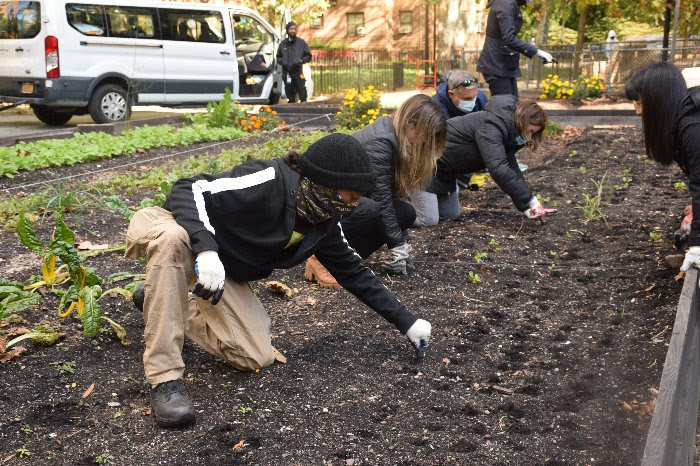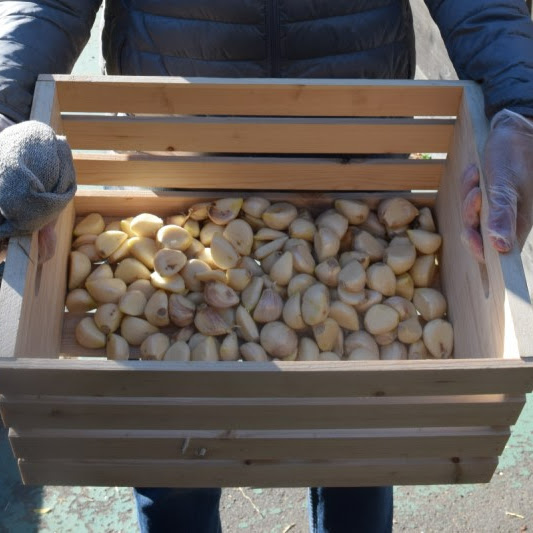We often get asked ‘What do the Corps Members do when it gets cold?’ or ‘What happens to the Eco-Hubs (farms) in the winter?’ The answer is A LOT! We certainly welcome the reprieve of intense heat from the summer, but it’s a quick transition from clearing weeds in the summer to collecting fallen leaves in the fall and clearing snow in the winter.
Here are things we do to Welcome Winter at our Eco-Hubs.
Let’s start with stewarding our soil. We take care of our soil in the winter by growing cover crops. Typically ryegrass or a blend of grasses, legumes, and oats, these crops are not meant to be eaten but help our soil in a number of ways. Without anything growing, soil is prone to erosion, and gusts of wind blow soil away little by little. Cover crops physically protect the soil, and their roots help hold soil in place. Cover crops also act as organic fertilizers in two ways. First, legumes have a unique property in that they fix nitrogen, a critical nutrient for crops, in the soil. Bacteria that grow on the roots of legumes convert nitrogen in the air into a form that plants can use, helping replenish nitrogen levels in the soil for spring growing. Second, in the spring, these crops become what’s called ‘green manure.’ We pull the crops up, chop them up, and mix them into the soil where they decompose and add nutrients back in – a form of in-bed composting.

|
|---|
Growing
In November, we plant garlic bulbs, which can withstand the cold winter temperatures and is ready for harvesting in July. There are some hearty crops like carrots, spinach, and collards that can indeed withstand the cold with just a bit of protection in the form of row cover.
We did have a successful over-wintering season from fall 2019 into spring 2020, yielding nearly 2000lbs of fresh produce in April and May of 2020. This harvest was particularly important because not only were we unable to start our next cohort and begin our spring planting due to the pandemic, but it also enabled us to have food to provide to the community during a time of high need.
We are excited for an even more productive winter and spring coming up because of our new high tunnel(s). We built one at Forest Houses in October, and we’ve got another one on the way at Bay View. Not only will we be able to grow more over the winter, but we will also be able to do more seed-starting, growing our own crops to transplant in the spring rather than purchasing from a nursery.

Garlic bulbs ready for planting!
Rebuilding and preparing
Lastly, winter is a time to repair, reflect, and plan. Bed repairs and maintenance are priority winter projects with some of our Eco-Hubs more than five years old. The amount of work completed on our Eco-Hubs throughout the year coupled with weathering puts a tremendous amount of wear on the physical infrastructure at the Eco-Hubs. This time for us is vital as we prepare for the deep winter and prepare for the coming harvest.
Our team also takes advantage of this time to reflect on the past year – reviewing and analyzing our data, what worked well and what didn’t, and exploring how we connect to the community to continue to serve them better. We take what we learn and plan for the year ahead through crop planning, ideating on programming for the community, and plotting out the next year’s projects.
All of this work is made possible by the incredible partnerships we have throughout our NYCHA community, Americorps, and a great number of supporters. We ask that you help us keep this incredible work going by donating to our end-of-year campaign. We have set an ambitious $30,000 goal that will, in part, go toward our continued work shared in this email.
In Partnership,
Erin Johnson
Director of Service
